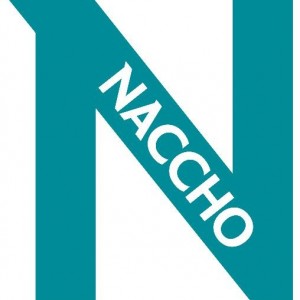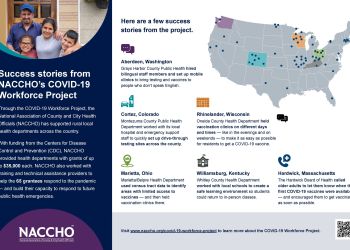Kristina Wieghmink
Ottawa County Department of Public Health, Michigan
December 7, 2015
Do people in your community recognize your health department, what you do, why you matter, and how you make a difference in their lives? If you do not intentionally form your identity and public perception, then others will do it for you. Here is how we strengthened our department’s culture and image.

Using our brand at the Grand Valley State University student outreach event to promote our Wear One campaign
I was hired in February 2013 and noticed our department was called by different names (e.g., County of Ottawa Public Health, Ottawa County Health Department, and more). In March, I approached my supervisor, the assistant health officer, and shared the importance of branding and consistent messaging (see Why Brand). I also conveyed how a brand intentionally shapes an organization’s identity, and without it, people may misunderstand or minimize our role in the community.
We needed a brand that was more than a name, logo, promotional campaign, or brochures; one that was strategically developed to maximize visibility and shape public perception. Our brand was to be a visual and verbal expression of our culture (who we are), services (what we do), mission and vision (where we are going), and values. Our goal was to create methods to engage people, tell stories, and send out a call to action; to result in strengthened credibility, increased public trust, and effectively making change.
I began the branding process with research. Some questions included, What’s our purpose? Who do we serve? What are their needs? How do we make a difference? Why do we come to work? Do our actions and attitudes align with our mission, vision and values? How do people perceive us? How do we connect and engage people? What communication methods do we use? What’s our SWOT? What data and evaluations guide our decision-making? What do we want to accomplish?
Next, I presented my findings to the assistant health officer and health officer. From there, we began brand development (name, logo, action messages, and Brand Guidelines). In April, we consulted with department leadership teams. Their engagement and feedback were essential to create a successful brand. With their support of the initiative, I presented in May to the Ottawa County Health and Human Services committee and county administrator. The committee agreed to proceed with our branding proposal, and added it to the Board of Commissioners’ June session agenda. The board approved and then we were ready to reveal our brand. I trained department staff members, went through the brand guidelines, provided brand templates and explained the process of developing communication plans together. I also wrote articles about our new brand for the County Administrator’s Digest and in our 2013 Annual Report (page 23).
Surprisingly, the branding process approval went through the layers of local government in less than five months. However, we recognized without a budget, brand awareness was going to be a challenge. We knew the most effective method was for staff members to use our brand consistently and create positive customer experiences by providing excellent service. I continually work with staff members by creating communication plans to help ensure consistency with our brand’s visuals, messages, tell our stories, maximize our reach, and meet our objectives (see project examples).
I also work with several community organizations, universities, and local health departments throughout the country to share our experience and encourage others to also develop a brand. In addition, we are honored and excited to be a recipient of several National Public Health Information Coalition (NPHIC): Awards of Excellence in Public Health Communications. This recognition helps us to increase brand awareness and provide guidance to other agencies (see project awards).
We learned a consistent and unified brand helps us strengthen our culture; provide focus, clarity and energy; increase community partnerships; understand who we are, why we do what we do and how we make a difference; know every staff member is a part of maintaining a positive brand; gain recognition and referrals from individuals, families, community organizations and businesses; build confidence and credibility with the media, public, leaders and policymakers; and increase funding and policy making opportunities.
My advice is to consider developing a brand, if you do not already have one. Designate a person or a group of people to facilitate the process and manage consistent communications to the media and public. A committed public health communicator must create communication plans, coordinate messages with the experts, tell stories, respond immediately to the media/social media, help promote health education, be prepared with crisis communications, understand the community’s health needs, and be up-to-date on what’s new in the media and any other communications aspect. This work will increase support of local health departments and positive public perceptions.
We learned it is essential to engage leaders and staff members for successful outcomes. In addition, it became evident that development and implementation of a brand does not happen overnight. It’s a strategic and thorough process. A successful brand is built from the inside out when all communications are credible, relevant, and timely.
See more resources:
OCDPH Brand Guidelines & Communication Policy
OCDPH’s Communications Plan Worksheet
OCDPH’s Communication Project Examples
NACCHO’s “In support of public health communicators”
Do people in your community recognize your health department, what you do, why you matter, and how you make a difference in their lives? If you do not intentionally form your identity and public perception, then others will do it for you. Here is how we strengthened our department’s culture and image.









